
Facebook business strategy integrates the following four principles: 1. Extensive and continuous focus on user experience. Facebook did not have a first mover advantage in online social networking segment, as it was launched after Friendster and MySpace. Nevertheless, an uncompromised approach on user experience and an adequate balance between standardisation and customization of the website resulted Facebook becoming the most popular social networking site within a matter of a couple of years. 2. Growth via acquisitions. Facebook business strategy focuses on establishing presence in various branches of e-commerce via acquiring relevant businesses. In 2014, the company purchased Oculus VR, Inc. (Oculus), a company developing virtual reality technology and WhatsApp Inc. (WhatsApp) messenger application for mobile devices. Earlier in 2012, Facebook bought Instagram a popular photo-sharing application for USD 1 billion cash and stock.[1] In 2015 the company generated revenues of USD17.93 billion, which is an increase of 44% year-over-year and ad revenue was of USD17.08 billion, which is an increase of 49% compared to the previous year.[2] Solid financial position that can enable more strategic acquisitions in the future is one of the key sources of Facebook competitive advantage. 3. New product development. Development of new products and services is placed at the core of Facebook business strategy with positive implications on the numbers of its user base. Currently, Facebook product portfolio includes Profile, News Feed, Messenger, Groups, Events, Video, Photos, Search, Pages, Instagram and others. The ability to develop new products and services according to its mission statement “to give people the power to share and make the world more open and connected”[3] is one of the key competitive advantages of Facebook. 4. Continuously exploring new ways of monetization. Facebook constantly experiments with different strategies finding and utilizing news ways of monetization in a regular manner. Recently, mobile user…
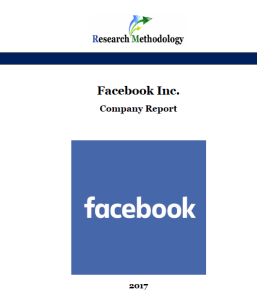
Facebook Inc. is a social media giant that owns Facebook, Instagram, WhatsApp, Oculus and a range of other e-commerce businesses. Founded in 2004 in Harvard University dormitory by Mark Zuckerberg and several of his classmates, Facebook emerged to become the most popular social media site in the world attracting more than 1.13 billion daily active users and 1.03 billion mobile daily active users (Stats, 2016). Facebook’s mission statement is “to give people the power to share and make the world more open and connected” (Annual Report, 2015) and the company generates revenues from selling advertising placements to marketers. Facebook business strategy is associated with an extensive and continuous focus on user experience, growth via acquisitions, new product development and continuously exploring the new ways of monetization. The social media company employs more than 12600 people globally and in 2015 the company generated revenues of USD17.93 billion, which is an increase of 44% year-over-year and ad revenue was of USD17.08 billion, which is an increase of 49% compared to the previous year (Annual Report, 2015). Facebook has been successful in efficient capitalization on mobile advertising and its evolving role as a news source for increasing numbers of its users has positive implications on the long-term growth prospects of the business. At the same time, the social media company is not free of weaknesses and its major weaknesses include the dependence of revenues only on advertising, challenges in sustaining the growth rate of revenues and the dependence of the business on a few key personnel such as Mark Zuckerberg and Sheryl Sandberg. Facebook Inc. Report contains the application of the major analytical strategic frameworks in business studies such as SWOT, PESTEL, Porter’s Five Forces, Value Chain analysis and McKinsey 7S Model on Facebook. Moreover, the report contains analyses of Facebook’s business strategy,…
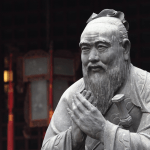
This essay critically analyses the level of destructive impact of colonialism on China’s growth output between the 1840s and the 1940s. The essay contains the contrast of opposite arguments regarding the topic and supports the argument confirming destructive impact of colonialism on China’s growth output between the 1840s and the 1940s by providing relevant and valid justifications. A study of economic history can provide valuable knowledge to economic theorists and practitioners in terms of dealing with economic challenges of present and the future. An in-depth analysis of factors causing the level of economic growth to slow down in particular is necessary so that these factors can be dealt with to fuel economic prosperity in any given region. Colonialism can be defined as “the control or governing influence of a nation over a dependent country, territory, or people” (Colonialism, online, 2016). While forming new colonies may prove to be a profitable strategy for powerful countries in many levels, economies that become victim to colonialism experience a set of substantial economic and social setbacks such as loss of sovereignty in terms of using economic resources, and negative impact upon cultural identity. The essay starts with assessing the level of China’s economic growth between the 1840s and the 1940s providing evidences why it was slow for this specific period. This is followed by discussions of colonialism and its negative impacts on the level of China’s economic growth between the 1840s and the 1940s. In order to adhere to the specified word limit for this essay political implications of colonialism are not addressed in this essay, and the main focus have been made on effects of colonialism on national economics using the case study of China. Moreover, an alterative viewpoint on the issue is also explored in this essay by assessing the impact of…
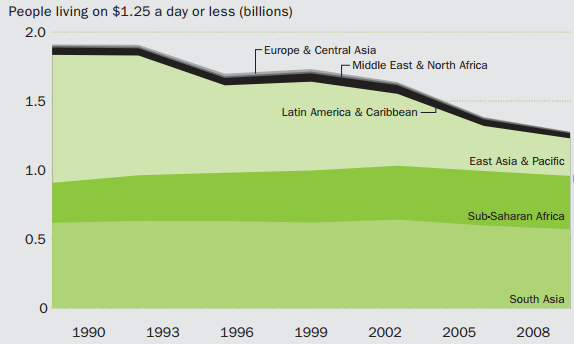
Rapid technological development during the last several decades coupled with a series of breakthroughs in information technology has immensely contributed to the development of national economies for a wide range of countries with positive implications on standards of life of people. At the same time, global poverty still remains one the most pressing issues with almost half of the world – more than 3 billion people living on less than $2.50 a day (Shah, 2016, online). The issue of global poverty is periodically addressed by a set of organisations such as World Bank, One International, WHO, CARE and others, as well as, within the framework of The Group of Twenty (G20) forum. This article represents a critical assessment of the role of World Bank in particular in dealing with global poverty. The article starts with the general discussions about the World Bank and its current contribution in eliminating global poverty. This is followed by analysis of criticism of World Bank performance in dealing with global poverty. Moreover, this article identifies potentials for World Bank to deal with global poverty more effectively. The World Bank Group is an international financial institution that pursues its mission of ‘Help Reduce Poverty’ with the participation of 188 countries. The World Bank Group consists of five organisations that are The International Bank for Reconstruction and Development (IBRD), The International Development Association (IDA), The International Finance Corporation (IFC), The Multilateral Investment Guarantee Agency (MIGA), and The International Centre for Settlement of Investment Disputes (ICSID). Each of these organisations contributes to World Bank mission in a unique way. It is important to clarify that generally the term ‘World Bank’ refers to only IBRD and IDA, and these two organisations along with IFC, MIGA, and ICSID are incorporated within the World Bank Group. Within the scope of this…

Gap Inc. management rightly acknowledges Corporate Social Responsibility (CSR) as one of the critically important aspects of the business. The company has won a number of awards for its CSR programs and initiatives, including 2016 Catalyst Award in recognition of its commitment to equality, diversity and inclusion[1]. Moreover, in 2015 Gap Inc. was named as The Most Ethical Company by The Ethisphere Institute.[2] Gap Inc. releases Global Sustainability Report annually and it includes the details of CSR programs and initiatives engaged by the company. The table below illustrates the highlights from the latest report for 2013-2014: Categories of CSR activities Gap Inc. CSR Performance Supporting local communities Gap’s employees volunteered 558,000 hours in 2014 alone Educating and empowering workers The company provided job training and store internships through its This Way Ahead program to more than 2000 teens and young adults. Labor and human rights Over the past several years the company raised the hourly wage to USD 10 for more than 60,000 employees Employee health and safety The company has a centralized online reporting system that tracks all incidents and injuries. The information is analyzed at least quarterly to assess risks and develop prevention measures Gender equality and minorities P.A.C.E. program aims to support female employees and suppliers gain the skills and confidence to advance at work and at home. The program aims to educate one million women throughout the world by 2020. Gap Inc. pays female and male employees equally for equal work In 2015, women represented more than 70 per cent of Gap’s senior leadership. The company sponsored 6 employee resource groups to promote diversity and inclusion. Environment a) energy consumption b) water consumption c) Waste reduction and recycling d) CO2 emissions The fashion retailer has…
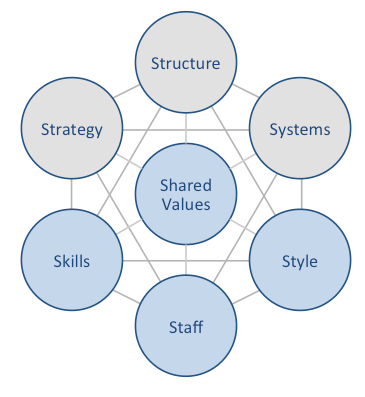
Gap Inc. McKinsey 7S model explains how seven elements of businesses can be aligned to increase the overall effectiveness. According to McKinsey 7S framework strategy, structure and systems represent hard elements, whereas shared values, skills, style and staff are soft elements. The essence of this model is this: there are links between elements in a way that a change in one element causes changes in others. As it is illustrated in figure below, shared values are positioned at the core of Gap Inc. McKinsey 7S framework, since shared values guide employee behavior with implications in their performance. Gap Inc. McKinsey 7S Framework Hard Elements Strategy. Gap Inc. uses cost leadership business strategy for all five brands within its portfolio – Gap, Banana Republic, Old Navy, Athleta, and Intermix. The company offers fashion, apparel and accessories products for much cheaper prices compared to the prices of premium fashion brands such as Prada, Dolce & Gabbana and Gucci. In other words, Gap Inc. business strategy capitalizes on the willingness of consumers to express themselves via clothes, to feel stylish, ‘cool’ and trendy in the cost effective manner. Structure. Gap organizational structure is hybrid and it integrates certain elements of divisional and hierarchical organizational structures. Gap organizational structure is divided into five divisions with each division representing a separate brand and headed by a president. At the same time, the organizational structure of each division is highly hierarchical and there are multiple levels of management between the president of the division and a shop floor assistant. Systems. There is a wide range of systems such as supply-chain system, quality control system, sales system, finance system, employee selection and recruitment system and others that facilitate Gap Inc. business operations. The company subjects the level of efficiency of its system into a critical analysis in…

Value chain analysis is a strategic analytical tool that analyses the sources of value creation for businesses. Gap Inc. value chain analysis presented below critically analyses the most important primary and support activities that contribute to the competitive advantage of the apparel and accessories retailer. The figure below illustrates the essence of value chain analysis. Gap Inc. Value chain analysis Primary Activities Inbound logistics Gap Inc. inbound logistics involves purchasing from about 1,000 vendors that have factories in about 40 countries. During the fiscal year of 2015, approximately 99 percent of purchases, by dollar value, were from factories outside the United States, while the remaining 1 percent of all purchases were from domestic factories. Moreover, about 24 per cent of total purchases by dollar value during the same period were made from factories based in China.[1] Due to the massive purchase volumes, economies of scale can be specified as the main sources of value creation for Gap Inc. Moreover, the company benefits from strategic, long-term relationships with its suppliers. In 2016, the company embraced supplier transparency practices disclosing the list of factories that produce its clothes around the world.[2] Operations GAP Inc. business operations are conducted in two formats[3]: Gap Inc. has company-operated stores in the United States, Canada, the United Kingdom, France, Ireland, Japan, Italy, China, Hong Kong, Taiwan, and beginning in October 2015, Mexico. The company also has franchise agreements with unaffiliated franchisees to operate Gap, Banana Republic, and Old Navy stores throughout Asia, Australia, Europe, Latin America, the Middle East, and Africa. Gap Inc. has 3,721 company-operated and franchise store locations throughout the world. The company derives value in operations primary activities mainly through opening its stores in locations and shopping centers frequently attended by the representatives of the target customer segment. Outbound logistics Gap Inc.…
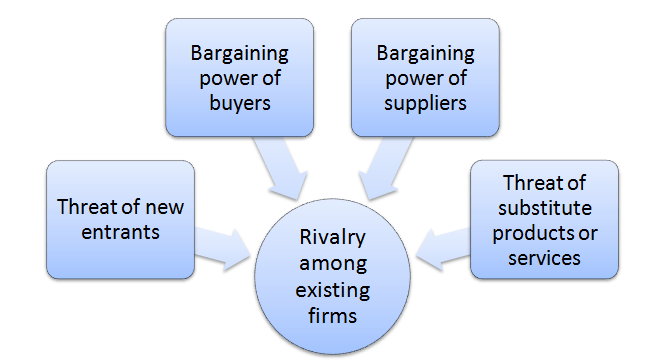
Gap Inc. Porter’s Five Forces analysis includes a critical analysis of five separate forces that shape the overall extent of competition in fashion, apparel and accessories industry. Developed by Michael Porter (1979)[1], five forces analysis remains as one of the most important strategic analytical tools for competitive analysis for more than three decades. Figure 1 below illustrates the essence of Porter’s Five Forces. Figure 1 Gap Inc. Porter’s Five Forces Rivalry among existing firms clothing and accessories industry is fierce. Gap Inc.’s major competitors include Abercrombie & Fitch Co., American Eagle Outfitters, Inc., Belk, Inc., Guess, Inc., J. C. Penney Company, Inc., J.Crew Group, Inc., Michael Kors Holdings Ltd, Urban Outfitters, Inc., Williams-Sonoma, Inc. and others. It is important to note that “despite being one of the bigger apparel players in the U.S., Gap Inc. holds less than 5% market share, which clearly indicates the diverse nature of the U.S. apparel industry. Higher shares are held by multi-brand retail chain Macy’s (9%) and general merchandise retailer Wal-Mart (over 7%). J.C. Penney (3.3%) and Target (5.4%) also hold a similar portion of the market, and American Eagle Outfitters, Aeropostale and Abercrombie & Fitch together account for just over 2% of total U.S. apparel sales.”[2] The figure 2 below illustrates a rough pattern of retail landscape in the US. Figure 2 Apparel market share in the US Bargaining power of Gap Inc. suppliers is low. The company purchases from about 1000 suppliers with factories in about 40 countries. Gap’s two largest vendors each accounted for only about 5 percent of the dollar amount of its total fiscal 2015 purchases[3]. Accordingly, Gap Inc.’s business is not dependent on any particular supplier and this fact increases its bargaining power in dealing with supplies. Furthermore, for the majority of suppliers it is critically important to have business with Gap Inc. due to the high volume of…
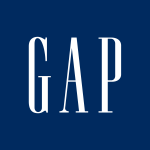
Gap Inc. marketing communication mix comprises print and media advertising, sales promotions, events and experiences, public relations and direct marketing as discussed below. Advertising Gap Inc. uses print and media advertising extensively as one of the main tools to communicate the marketing message to the target customer segment. In 2015, the company spent USD164 million on measured media in the U.S., a 26.4% decline over 2014[1]. The most popular platforms used by Gap Inc. include magazines and journals, TV, radio and banners on city centers. In 2016, Gap’s Athleta brand released its first TV advertisement with the campaign ‘Power of She’ focused on female empowerment supporting the debut of the Athleta Girl apparel line, which targets ages six to 14.[2] Moreover, viral marketing represents an important additional tool within Gap Inc. marketing strategy and the company has a history of using viral marketing in a controversial manner. Specifically, the company’s Twitter campaign included an image of “two white girls in poses that look quite painful, next to a third white girl using a smaller black girl as an armrest”[3] The campaign caused a massive controversy and debate attracting thousands of retweets and likes, the story being covered by more than 214 news articles.[4] Another instance of Gap marketing campaign involved an image of a happy interracial family, causing debates on social media platforms about the issue of interracial marriage. Sales Promotion As a fashion, apparel and accessories retailer, Gap Inc. uses various sales promotions techniques. The use of sales promotions by Gap has the following patterns: 1. Loyalty cards– Each brand within Gap Inc. portfolio – GAP, Old Navy, Banana Repubic and Athleta offers its own gift card, as well as, electronic gift card. A gift card by any above brand can be used across all Gap Inc. sites and…
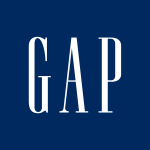
Gap Inc. segmentation, targeting and positioning practices refer to ways in which the fashion and accessories retailer identifies specific groups within the population to sell their products to and increases the attractiveness of its products to this specific group of buyers. Segmentation includes dividing population into groups according to certain characteristics, while targeting implies choosing specific groups identified as a result of segmentation to sell products. Positioning refers to the selection of the marketing mix that is the most attractive for the target customer segment. Gap Inc. uses multi-segment type of positioning and accordingly, the company exploits more than one customer segment with different brands within its portfolio. For example, Gap brand targets individuals interested in American casual style, whereas the target customer segment for Athleta includes fitness-minded women. The company also uses imitative positioning style occasionally by imitating the design of luxury clothing brands such as Ralph Lauren Corporation, Versace, Giorgio Armani, Louis Vuitton and others. The following table illustrates Gap Inc. segmentation, targeting and positioning: Type of segmen- tation Seg- Men-tation crite-ria Gap Inc. Target Customer Segment Gap Banana Republic Old Navy Intermix Athleta Geogra-phic Region North America Asia, Europe North America Asia, Europe North America Asia North America North America Den-sity Urban, Rural Urban, Rural Urban, Rural Urban Urban Demog-raphic Age 3 – 45 18-40 3 – 40 18 – 45 16 – 50 Gen-der Males & Females Males & Females Males & Females Males & Females Females Life-cycle stage Bachelor Stage Newly Married Couples Full Nest I Full Nest II Bachelor Stage Newly Married Couples Full Nest I Bachelor Stage Newly Married Couples Full Nest I Bachelor Stage Newly Married Couples Full Nest I Bachelor Stage Newly Married Couples Occupation Students, employees, professionals Students, employees, professionals Students, employees, professionals…
